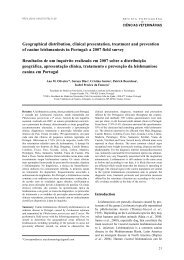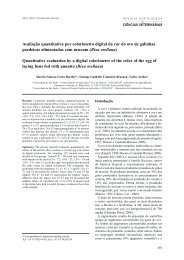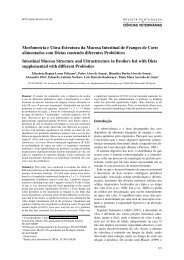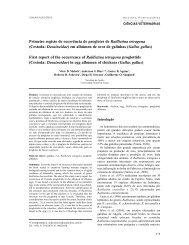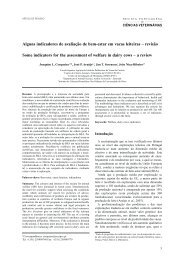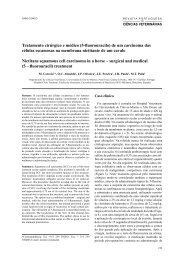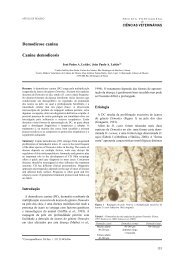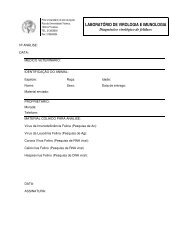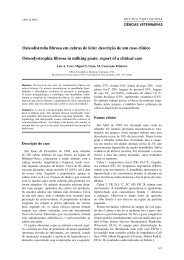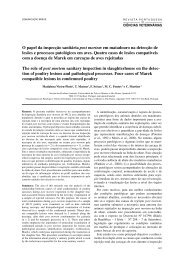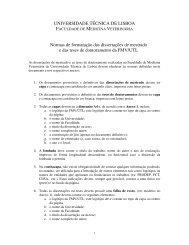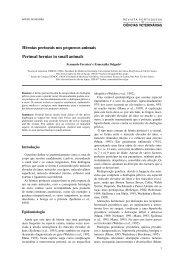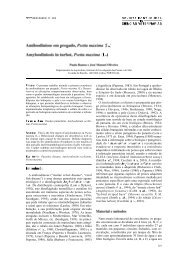Fish vaccination against infections by Streptococcal species and the ...
Fish vaccination against infections by Streptococcal species and the ...
Fish vaccination against infections by Streptococcal species and the ...
You also want an ePaper? Increase the reach of your titles
YUMPU automatically turns print PDFs into web optimized ePapers that Google loves.
Gomes S e Afonso A<br />
highly diverse repertoire of antigen receptors allows<br />
<strong>the</strong> adaptive immune system to recognize virtually any<br />
antigen (Medzhitov <strong>and</strong> Janeway, 2000).<br />
Prophylactic methods <strong>against</strong> fish diseases<br />
During <strong>the</strong> last decades, <strong>the</strong>re has been a continuous<br />
growth of aquaculture industry all over <strong>the</strong> world<br />
(Hastein, 1995). The most significant growth has been<br />
seen in carp production as well as in <strong>the</strong> production of<br />
o<strong>the</strong>r cyprinids <strong>and</strong> even more so for carnivorous fish<br />
<strong>species</strong> such as salmonids, which are farmed in intensive<br />
conditions (Gudding et al., 1999). However, any<br />
intensive bioproduction – whe<strong>the</strong>r on l<strong>and</strong> or at sea –<br />
will experience disease problems (Hastein, 1995).<br />
Infectious diseases that occur as sporadic events in<br />
wild fish populations may cause high mortalitities<br />
when appearing in intensive fish farming (Gudding et<br />
al., 1999). For <strong>the</strong> aquaculture industry to prosper in<br />
<strong>the</strong> future it is a prerequisite that <strong>the</strong> losses caused <strong>by</strong><br />
diseases <strong>and</strong> <strong>the</strong> use of antibiotics are kept to a minimum.<br />
Immunoprophylaxis recognized <strong>by</strong> stimulation<br />
of non-specific <strong>and</strong> specific immunity is consequently<br />
<strong>the</strong> method adopted for developing aquaculture into a<br />
sustainable bioproduction in <strong>the</strong> aquatic ecosystems.<br />
<strong>Fish</strong> can be immunized in three ways: <strong>by</strong> injection<br />
preferably intraperitoneally, <strong>by</strong> immersion, usually <strong>by</strong><br />
dipping <strong>the</strong> fish in a diluted vaccine solution, or <strong>by</strong><br />
oral administration along with food. These methods<br />
have different advantages <strong>and</strong> disadvantages with<br />
respect to <strong>the</strong> level of protection, side effects, practicability<br />
<strong>and</strong> cost-efficiency. Injection <strong>and</strong> immersion<br />
are <strong>the</strong> two major methods that have been developed<br />
for use at an industrial scale <strong>and</strong> in commercial production<br />
of salmonids <strong>and</strong> both <strong>vaccination</strong> procedures<br />
are established practices <strong>and</strong> integrated as part of <strong>the</strong><br />
production routines.<br />
There is still a limited underst<strong>and</strong>ing of <strong>the</strong> mechanisms<br />
involved in antigen uptake <strong>and</strong> presentation after<br />
immersion <strong>and</strong> oral <strong>vaccination</strong> (Nakanishi <strong>and</strong> Ototake,<br />
1997; Quentel <strong>and</strong> Vigneulle, 1997; Moore et al., 1998).<br />
Even so, <strong>the</strong> first encounter with pathogens occurs<br />
through <strong>the</strong> mucosal surfaces <strong>and</strong> <strong>the</strong> indisputable presence<br />
of a mucosal associated immune system makes antigen<br />
delivery through <strong>the</strong> mucosal surfaces a viable approach.<br />
The mucosal immunity of fish is still a poorly explored<br />
field of research, although indications are available for<br />
<strong>the</strong> existence of this type of immunity (Rombout <strong>and</strong><br />
Joosten, 1992). Especially for fish living in a pathogen-<br />
-rich aquatic environment, <strong>the</strong> existence of a mucosal<br />
immune system may be very important. In fact, compared<br />
with higher vertebrates fish have <strong>the</strong>ir skin as an<br />
extra mucosal barrier. However, an important criterion<br />
for <strong>the</strong> existence of a mucosal immune system is <strong>the</strong><br />
secretion of antigen-specific antibodies at mucosal surfaces<br />
(Rombout <strong>and</strong> Joosten, 1992).<br />
Oral <strong>vaccination</strong> research has so far focused on protecting<br />
<strong>the</strong> antigen from digestion <strong>and</strong> decomposition<br />
26<br />
during passage through <strong>the</strong> stomach <strong>and</strong> anterior part<br />
of <strong>the</strong> gut. The ultimate goal has been to stimulate <strong>the</strong><br />
immunocompetent tissues in <strong>the</strong> posterior part of <strong>the</strong><br />
intestine. Different approaches have been tried, one of<br />
<strong>the</strong> latest using antigens encapsulation in alginate <strong>and</strong><br />
liposome microcapsules (Joosten et al., 1997).<br />
The optimal way of developing an effective vaccine<br />
entails <strong>the</strong> identification of <strong>the</strong> pathogens’ key virulence<br />
factors. Fur<strong>the</strong>r, <strong>the</strong> induction of <strong>the</strong> immune<br />
response must be optimized so that <strong>the</strong> vaccinated animal<br />
develops a protective immunity <strong>against</strong> <strong>the</strong><br />
pathogen (Gudding et al., 1999).<br />
Vaccines <strong>and</strong> adjuvants<br />
RPCV (2006) 101 (557-558) 25-35<br />
Inactivated vaccines (bacterins)<br />
A common approach in vaccine production is to<br />
inactivate <strong>the</strong> pathogen <strong>and</strong> toxins <strong>by</strong> physical (e.g.<br />
UV <strong>and</strong> heat) or <strong>by</strong> chemical (e.g. kill <strong>by</strong> formol)<br />
means so that it is no longer capable of replication in<br />
or damaging <strong>the</strong> host. It is critically important to<br />
maintain <strong>the</strong> structure of epitopes on antigens during<br />
inactivation. Administration of <strong>the</strong>se bacterins is done<br />
<strong>by</strong> injection or immersion. Provided that <strong>the</strong> serotypes<br />
used for vaccine preparation cover <strong>the</strong> field of virulent<br />
strains <strong>and</strong> that <strong>the</strong> vaccines are used correctly, <strong>the</strong>se<br />
vaccines are usually effective <strong>and</strong> give negligible side<br />
effects (Stevenson, 1997; Toranzo et al., 1997). Most<br />
vaccines used in aquaculture to date have been inactivated,<br />
bacterial vaccines (Gudding et al., 1999).<br />
Live vaccines<br />
Live, attenuated vaccines should potentially have<br />
many advantages in aquaculture (Benmansour <strong>and</strong> de<br />
Kinkelin, 1997). Vaccination with a live vaccine is in<br />
reality an infection (with an attenuated strain), <strong>and</strong> if<br />
vaccinated fish sheds <strong>the</strong> vaccine strain, an effective<br />
dissemination of <strong>the</strong> antigen in <strong>the</strong> production would<br />
take place over an extended time period. Live vaccines<br />
also have <strong>the</strong> advantage of stimulating <strong>the</strong> cellular<br />
branch of <strong>the</strong> immune system (Marsden et al., 1996).<br />
Finally, attenuated vaccines have some economical<br />
advantages in terms of simple delivery <strong>and</strong> low dose<br />
requirements due to multiplication in <strong>the</strong> fish<br />
(Gudding et al., 1999). However, <strong>the</strong> risk of reversion<br />
to virulence is still poorly understood <strong>and</strong> <strong>the</strong>re seems<br />
to be a general view that <strong>the</strong> risks associated with live<br />
vaccines in aquaculture, whe<strong>the</strong>r produced <strong>by</strong> conventional<br />
methods or <strong>by</strong> recombinant techniques should<br />
be heavily scrutinized.<br />
Vaccines based on DNA-technology<br />
In recent years, several vectors have been used for<br />
cost-effective production of sufficient quantities of<br />
protective antigens <strong>by</strong> recombinant DNA technology.



